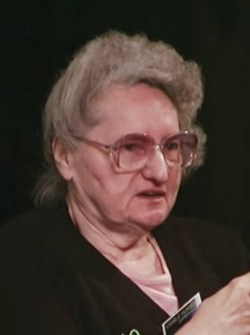This article is part of the series "A Moment in History" where we honor those who have contributed to the growth of medical knowledge in the areas of anatomy, medicine, surgery, and medical research.

Susan C. Potter
Image capture from a video
The title of this article is a reference to another article in this blog: “The unknown patient / donor” which honors all those who have anonymously donated their bodies to further the anatomical training of many in the medical field. They trusted that those who would use their bodies would do so ethically and with respect, but they did not know exactly how they were to be used or what was going to be done with their bodies.
Susan Potter was the exact opposite. She knew that her body was going to be coated with polyvinyl alcohol, frozen, cut into four pieces with a huge handsaw, and then it would be ground or milled into 27,000 slices of 63 microns each, which were to be photographed in exquisite detail.
She offered her body to science and spoke with Dr. Vic Spitzer, who had directed the Visible Human Project, the first digital cadaver in 1994. She agreed to the donation, but only after she had toured the facilities and only after she clearly understood what was going to her body and why.
The why is the most interesting part of her story. Susan had a very interesting medical history, including spinal surgery , double mastectomy, and a hip replacement. Normally her body would have been rejected, but doctors see this type of patients in their practices. Patients who are old, frail, with prior surgeries and a multitude of problems. This is why she was chosen
If images are needed, usually cadavers are scanned and imaged postmortem, but in her case, Susan underwent many imaging studies while she was alive. She was interviewed and filmed countless times so that her videos would be added to the digital cadaver that was going to be made of her, becoming de facto, a digital patient.
Susan donated her body in the year 2000 died of pneumonia in 2015. During those 15 years she became a friend of Dr. Spitzer, gave talks to medical students, and collaborated with this project.
National Geographic followed Susan for these 15 years and documented her life and death. You can read her story here or watch the video in this article. The development of the software continues. I am sure we will hear more from Susan Potter's contributions long after her death.
NOTE: My thanks to our contributor Pascalle Pollier for bringing Susan Potter to my attention. Dr. Miranda
“Clinical Anatomy Associates, Inc., and the contributors of "Medical Terminology Daily" wish to thank all individuals who donate their bodies and tissues for the advancement of education and research”.



